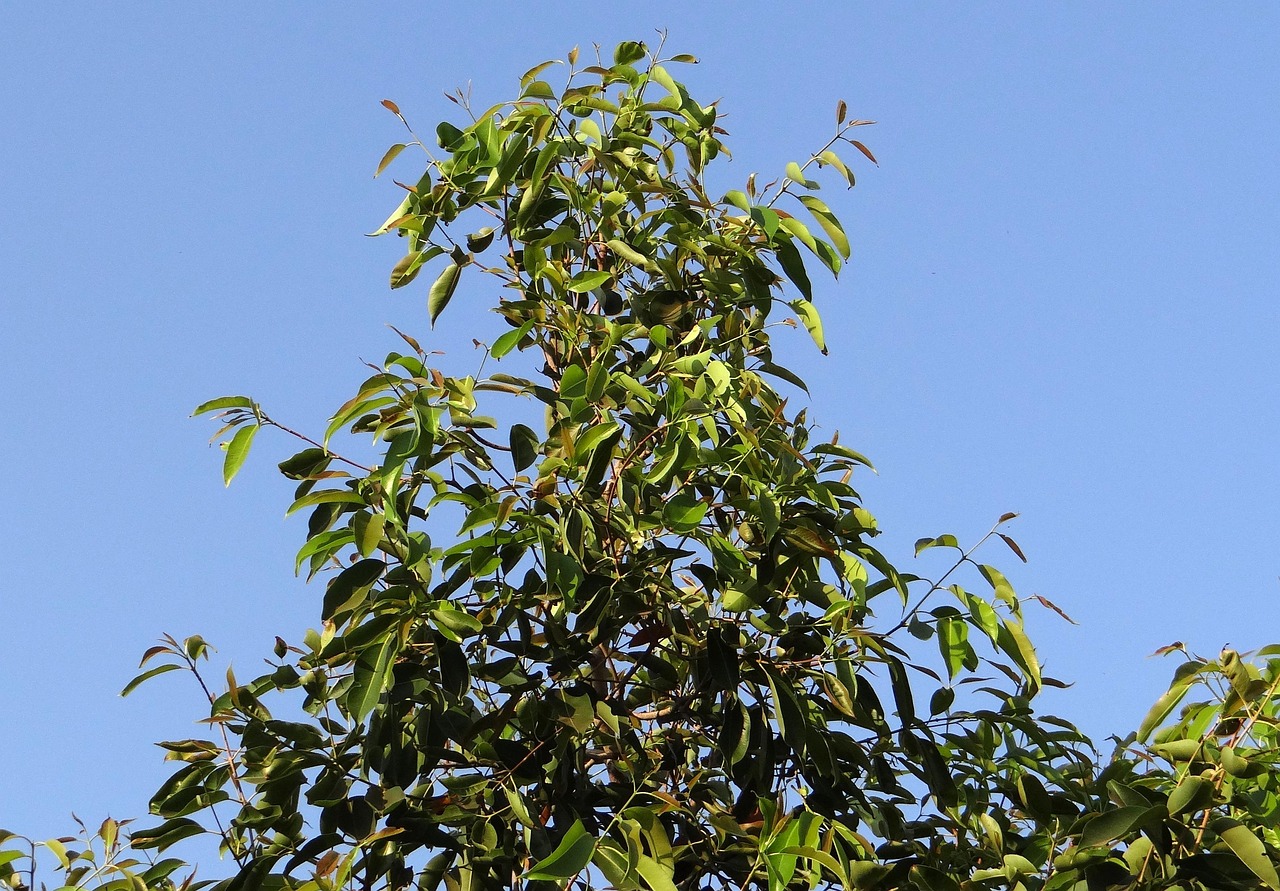The Jamun tree, also known as Syzygium cumini, exhibits a moderate growth rate in tropical gardens. Under optimal conditions, it can grow about 1 to 2 feet per year, reaching its full height of 30 to 100 feet in approximately 15 to 20 years.
Understanding the Jamun Tree
The Jamun tree is native to the Indian subcontinent and thrives in tropical and subtropical climates. It is admired not only for its lush green foliage but also for its sweet and tangy black fruits. The tree is known for its medicinal properties and is often planted in gardens for its aesthetic value and shade.

Ideal growth conditions for the Jamun tree include well-drained soil, adequate sunlight, and regular watering, especially during dry spells. In tropical gardens, these trees can flourish and provide numerous benefits, including improving soil quality and supporting local wildlife.
Growth Factors
The growth rate of the Jamun tree can be influenced by several factors. Understanding these factors can help gardeners optimize growth conditions. Key factors include:
- Soil Quality: The Jamun tree prefers loamy soil that is rich in organic matter.
- Watering: Regular watering during the initial growth period is crucial.
- Sunlight: Full sun exposure will promote faster growth.
- Temperature: The ideal temperature range is between 77°F to 95°F (25°C to 35°C).
Growth Stages of the Jamun Tree
The growth of a Jamun tree can be broken down into several stages. Each stage has distinct characteristics and growth rates:

| Growth Stage | Duration | Typical Height |
|---|---|---|
| Seedling | 0-1 year | 1-2 feet |
| Juvenile | 1-5 years | 5-10 feet |
| Mature | 5-20 years | 20-100 feet |
| Full Growth | 20+ years | 30-100 feet |
Maintenance Requirements
Caring for a Jamun tree involves several maintenance practices that enhance its growth potential. Here are some essential maintenance tips:
- Fertilization: Apply organic fertilizers during the growing season to boost growth.
- Pest Control: Regularly check for common pests and diseases that may affect the tree.
- Pruning: Prune the tree to promote air circulation and remove dead branches.
- Mulching: Use mulch to retain moisture and suppress weeds around the base of the tree.
Common Challenges in Growth
<pDespite being a resilient species, the Jamun tree faces certain challenges that can hinder its growth. Common issues include:
- Pests: Aphids and mealybugs can damage young leaves and affect overall health.
- Disease: Fungal infections like powdery mildew can weaken the tree.
- Drought: Insufficient water supply can stunt growth and lead to leaf drop.
Tropical gardeners should be aware of these potential challenges and take proactive measures to ensure the healthy development of their Jamun trees. By addressing these factors, gardeners can enjoy the beauty and benefits of this remarkable tree in their landscapes.

Propagation Techniques for Jamun Trees
Propagating Jamun trees can be done through various methods. Each method has its advantages and can affect the growth rate and health of the tree. Understanding these techniques is essential for gardeners looking to expand their Jamun orchards or create new trees in their tropical gardens.
Seed Propagation
Seed propagation is the most common method for growing Jamun trees. It is relatively simple and cost-effective. Here are the steps involved:
- Seed Collection: Collect ripe Jamun fruits from healthy trees. Ensure that the fruits are fully mature for optimal seed quality.
- Seed Preparation: Remove the seeds from the fruit and wash them to eliminate any pulp residue. Dry the seeds for a few days in a shaded area.
- Sowing: Plant the seeds in well-drained soil, about 1 inch deep. Water them lightly to keep the soil moist.
- Germination: Seeds typically germinate within a few weeks under favorable conditions.
Vegetative Propagation
Vegetative propagation involves using parts of the parent tree to grow new ones. This method can produce trees that retain the characteristics of the parent. Here are some common techniques:
- Cuttings: Take semi-hardwood cuttings from healthy branches during the growing season. Dip the cut ends in rooting hormone before planting them in a pot with well-draining soil.
- Grafting: This technique involves joining a stem from one tree (scion) to the rootstock of another. Successful grafting can lead to faster fruit production.
- Air Layering: In this method, a branch is partially girdled, and moist sphagnum moss is wrapped around it to encourage root development before being cut away and planted.
Optimal Conditions for Growth
For Jamun trees to thrive, certain environmental conditions must be met. These conditions can significantly influence their growth rate and overall health.

Soil Requirements
The soil quality plays a vital role in the growth of Jamun trees. Here are some key soil characteristics:
- Drainage: Well-draining soil is essential to prevent root rot. Sandy loam or clay-loam soils are ideal.
- pH Level: The optimal pH level for Jamun trees is between 6.0 and 7.5. Conducting a soil test can help determine if amendments are necessary.
- Nutrient Content: Enriching the soil with organic matter, such as compost, can improve nutrient availability and promote healthy growth.
Climate Considerations
The climate in which Jamun trees grow affects their growth and fruiting. Here are some important climatic factors:
- Temperature: Jamun trees prefer warm temperatures ranging from 77°F to 95°F (25°C to 35°C). They can tolerate slight fluctuations but may struggle in extreme cold.
- Humidity: High humidity levels benefit Jamun trees, especially during flowering and fruiting periods.
- Rainfall: Regular rainfall or irrigation is necessary, particularly in dry seasons, to support optimal growth.
Pest and Disease Management
A proactive approach to pest and disease management is crucial for maintaining healthy Jamun trees. Here are some strategies to consider:
Pest Control Methods
Identifying pests early can help minimize damage. Common pests include:
- Aphids: These small insects suck sap from leaves and can stunt growth. Use insecticidal soap or neem oil for control.
- Mealybugs: They appear as white cottony masses on stems and leaves. Remove them by hand or use a cotton swab dipped in alcohol.
Disease Prevention
Maintaining good cultural practices can reduce disease incidence. Some common diseases include:
- Powdery Mildew: This fungal disease appears as white spots on leaves. Improve air circulation and apply fungicides if necessary.
- Root Rot: Often caused by overwatering, root rot can be prevented by ensuring proper drainage.
By employing these propagation techniques, optimizing growth conditions, and managing pests and diseases effectively, gardeners can ensure a thriving environment for their Jamun trees in tropical gardens.
Harvesting and Usage of Jamun Fruits
The Jamun tree is celebrated not only for its majestic presence in tropical gardens but also for its delicious and nutritious fruits. Understanding the harvesting process and potential uses of Jamun fruits can enhance the gardening experience and provide additional benefits.
Harvesting Techniques
Harvesting Jamun fruits requires careful timing and technique to ensure the best flavor and texture. Here are some key points to consider:
- Timing: Fruits are typically ready for harvest during the summer months, usually between June and August. They should be picked when they turn a deep purple-black color.
- Method: Gently twist or cut the fruit from the stem. Avoid pulling too hard, as this can damage the tree and the remaining fruit.
- Storage: Freshly harvested Jamun fruits can be stored in a cool, dry place for a few days. For longer storage, consider freezing them or making preserves.
Uses of Jamun Fruits
Jamun fruits are not only tasty but also have numerous health benefits. Here are some popular uses:
- Fresh Consumption: Jamun fruits can be eaten raw as a snack. Their sweet and tangy flavor makes them a delightful treat.
- Juices and Smoothies: The fruits can be blended into refreshing juices or smoothies, providing a boost of vitamins and antioxidants.
- Preserves and Jams: Jamun can be cooked down with sugar to create delicious jams and preserves that capture their unique flavor.
- Medicinal Uses: In traditional medicine, Jamun seeds and leaves are often used to manage diabetes and improve digestion.
Nutritional Benefits of Jamun Fruits
Jamun fruits are not just delicious; they also pack a nutritional punch. Here are some key nutritional benefits:
| Nutrient | Amount per 100g |
|---|---|
| Calories | 60 |
| Carbohydrates | 14.5 g |
| Protein | 0.6 g |
| Fat | 0.1 g |
| Fiber | 2.2 g |
| Vitamin C | 18 mg |
| Calcium | 18 mg |
The high fiber content in Jamun fruits aids in digestion, while vitamin C supports the immune system. Additionally, the low-calorie count makes them an excellent choice for those looking to maintain a healthy diet.
Cultural Significance of the Jamun Tree
The Jamun tree holds cultural importance in many regions where it is grown. It is often associated with various traditions and beliefs.
Symbolism in Various Cultures
In India and other parts of South Asia, the Jamun tree symbolizes prosperity and fertility. It is often planted near homes to bring good luck. Additionally, the tree is featured in numerous folktales and traditional stories.
Culinary Traditions
The fruits are an integral part of various culinary traditions. In many regions, Jamun is used in local dishes, drinks, and desserts. Here are a few examples:
- Panchmel Dal: A traditional dish that may include Jamun as a side or ingredient.
- Jamun Rice: A sweet dish made by mixing cooked rice with mashed Jamun fruits and sugar.
- Sherbet: A refreshing drink made from the juice of Jamun mixed with water and sugar.
The cultural significance of the Jamun tree enhances its value in tropical gardens, making it not only a source of fruit but also a symbol of heritage and tradition.
Environmental Benefits of Growing Jamun Trees
Beyond their aesthetic appeal and fruit production, Jamun trees offer several environmental benefits. Here are some notable advantages:
Ecosystem Support
Jamun trees provide habitat and food for various wildlife species. Birds, insects, and mammals benefit from the fruits, while insects contribute to pollination.
Soil Improvement
The deep roots of Jamun trees help prevent soil erosion by stabilizing the soil structure. Furthermore, their leaf litter enriches the soil with organic matter, enhancing soil fertility.
Overall, incorporating Jamun trees into tropical gardens contributes positively to both the environment and local ecosystems while offering numerous practical benefits to gardeners and communities alike.
Additional Considerations for Growing Jamun Trees
While growing Jamun trees can be rewarding, there are several additional considerations that gardeners should keep in mind to ensure successful cultivation. These factors can further enhance the growth rate and overall health of the tree.
Climate Adaptability
Understanding the climate adaptability of Jamun trees is crucial for gardeners in different regions. While these trees thrive in tropical climates, they can also adapt to subtropical conditions. However, extreme cold can stunt their growth and affect fruit production. Gardeners in cooler regions should consider planting Jamun trees in sheltered locations that offer protection from frost.
Water Management
Water management is another critical aspect of cultivating Jamun trees. While they are tolerant of drought, consistent watering during the initial years is vital for establishing strong roots. Here are some tips for effective water management:
- Irrigation: Drip irrigation systems can provide consistent moisture while minimizing water wastage.
- Mulching: Applying organic mulch around the base of the tree helps retain soil moisture and suppress weeds.
- Monitoring: Regularly check soil moisture levels to avoid overwatering or underwatering the tree.
Companion Planting
Companion planting can enhance the growth and health of Jamun trees by creating a more diverse garden ecosystem. Suitable companion plants include:
- Citrus Trees: They attract pollinators and provide a complementary aesthetic.
- Leguminous Plants: Such as beans and peas, which fix nitrogen in the soil, improving fertility.
- Herbs: Like basil and mint, which can deter pests and enhance biodiversity.
Economic Benefits of Jamun Cultivation
The cultivation of Jamun trees also offers economic benefits that can be particularly advantageous for local farmers and communities. Here are some key economic aspects:
Fruit Market Potential
The demand for Jamun fruits increases during the harvesting season due to their popularity in local markets. Farmers can benefit financially by selling fresh fruits or processed products such as jams and juices. This can create additional income streams for households engaged in agriculture.
Agro-tourism Opportunities
Incorporating Jamun trees into agro-tourism ventures can attract visitors interested in experiencing the beauty of tropical gardens. Offering guided tours, fruit-picking experiences, or workshops on traditional uses of Jamun can enhance community engagement and generate revenue.
Sustainable Practices
Growing Jamun trees promotes sustainable agricultural practices. Their ability to improve soil health and support local ecosystems contributes to sustainable land use. This aligns with increasing global interest in environmentally friendly farming methods.
Final Thoughts
The Jamun tree serves as an excellent addition to tropical gardens, providing aesthetic appeal, nutritional benefits, and environmental contributions. Its moderate growth rate, coupled with its resilience, makes it a suitable choice for many gardeners. By understanding its requirements and best practices for care, individuals can cultivate healthy trees that yield delicious fruits while supporting local ecosystems.
The cultural significance of the Jamun tree further enhances its value, making it not just a fruit-bearing plant but also a symbol of heritage. As communities focus on sustainable practices and eco-friendly gardening, Jamun trees stand out as beneficial and versatile plants that enrich both gardens and local economies.
In summary, whether for fruit production, environmental benefits, or cultural significance, the Jamun tree is a remarkable species that deserves a place in tropical gardens around the world. With proper care and attention, gardeners can enjoy the many rewards this tree offers for years to come.
